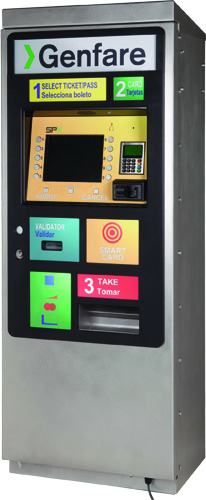
With roots dating back to 1880, SPX Genfare pushes forward with digital fares
By Tara Farnsworth
SPX Genfare, Charlotte, NC, builds from roots that date back to 1880 and the invention of the first farebox by Johnson Farebox Company, which acquired Cleveland Farebox in 1938. Both companies eventually folded into Keene in 1960, which another older company, General Signal, acquired, along with another of its competitors, Duncan, to form GFI Genfare in the early 1980s. SPX then acquired GFI Genfare in 1998 as part of the General Signal acquisition.
Today, SPX Genfare’s transit clients reach more than 3 billion commuters and collect approximately $5 billion in revenue annually. The company says its proven experience sets it apart and makes it uniquely qualified to continue partnering with transit agencies for many years to come.
“Genfare is continually looking to advance the state of the art in fare collection products and systems,” says Genfare President Kim Green. “With the long life-cycle of a fare system, what we are developing today must anticipate and allow for the addition of new features.”
One of Genfare’s marquee services is the e-GO™ interface, a web-based smart card sales and management system to assist individual passengers and large organizations by providing a user friendly interface allowing riders to buy fares, upgrade service, establish autopay functionality and even report a card lost or stolen. There’s also a guest option for riders who want the convenience of the card but do not want to establish a permanent account.
“The simplicity of e-GO is self-service,” says Tony Sharma, Genfare vice-president of Business Development. “It allows riders to buy and upgrade smart cards online using anything from a personal computer to a tablet or a phone.”
The e-GO website provides organizations and corporate partners with a dedicated website to purchase, issue, manage and track large volumes of cards for students or employees. The improved partnership between the transit agency and organization provides a more streamlined experience for riders.
The agency and customer service portion of the website provides the transit agency complete control. It gives agencies the freedom to run reports, providing a comprehensive picture of ridership and operations. e-GO improves cash flow by crediting daily receipts to agency accounts. Genfare says encouraging smart card use builds rider loyalty and decreases boarding times.
Additional e-GO Highlights include simple integration with an agency’s existing website, upgraded fare media, improved security for credit and debit card processing and comprehensive back-end reporting and analysis.
Genfare is in the process of launching three new e-GO web-based systems, one with SunTran in Tuscon, AZ, another with the Jacksonville Transportation Authority, Jacksonville, FL, and a third in Winnipeg, MB, Canada.
Genfare’s automatic fare collection system consists of fare collection devices, fare media and reporting systems. Its farebox has been a benchmark in the industry, and the company says that systems installed more than 20 years ago are still functioning efficiently through proper maintenance and upgrades.
Genfare has an internal team of software and technical support to answer transit agency questions and troubleshoot any maintenance issues. They also offer a wide variety of training to agencies as part of, or independent of, the initial installation.
The company has maintenance leaders and team members in their corporate offices on a regular basis, expanding knowledge and cross-training on products. They then bring that information back to train their internal workforce.
The newest product development at Genfare is the Vendstar-e ticketing machine. This innovative ticket vending machine accepts and securely processes credit and debit cards and then conveniently issues smart cards and/or magnetic cards for quick and easy passenger travel. The machine debuted at the APTA Annual Conference in Seattle, WA, in September.
The machine boasts a three-step user-friendly process for fare purchases and a 10-inch diagonal color display. Users can select up to two types of tickets, printed and encoded for flexibility and security. The machine validates purchased tickets and recharges previously purchased smart cards with a 300-millisecond processing time.
The Vendstar-e ticketing machine records individual sales and events with cumulative totals, uploaded to central offices in real-time. It communicates via Ethernet (copper or fiber optics) or mobile broadband. An uninterruptable power supply permits transaction completion during power outages. Built-in diagnostics allow for continuous monitoring of all modules.
Genfare will be delivering the Vendstar-e in early 2013 to New Orleans, LA, and Rochester, NY.
Genfare says it is always working on new designs and features in fare collection systems. It is currently in the final stages of pre-production design on a new farebox product that will incorporate all of the current fare technologies and become a platform to add new features and functionality in the years to come. Genfare will begin to offer this yet-unnamed product in 2013. BR
Tara Farnsworth is the marketing manager for SPX Genfare.


i wish my country will use one of this SPX Genfare machine..really good machine..